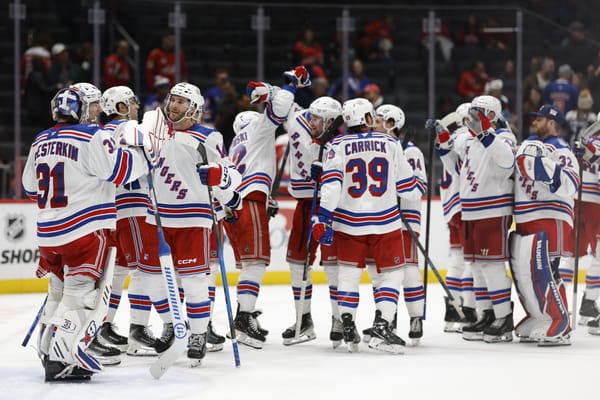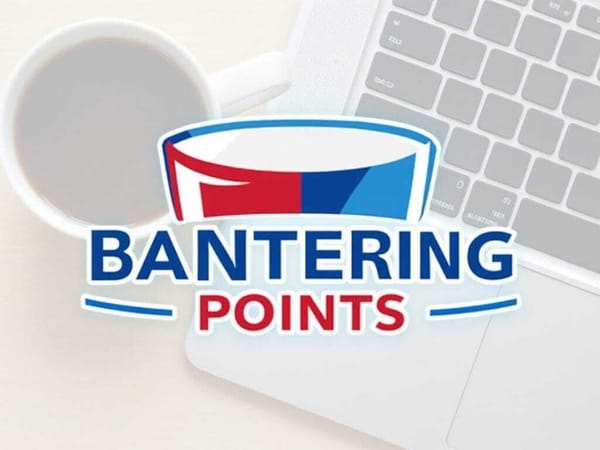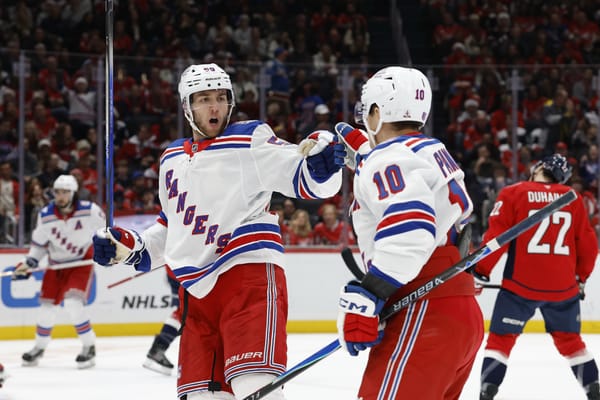Blueshirt Banter Proposes NHL Rule Changes
The BSB team got together and huddled, much like the on-ice officials after a controversial play.
Can you believe that August is almost over? The doldrums of the NHL offseason are finally lifting and Traverse City, training camp, and the preseason are just around the corner. To help get you through the home stretch we thought we’d do something a little bit different.
Six of Blueshirt Banter’s writers have come up with some rule changes that we think would improve the game in one way or another. What’s that? You think the rules are just fine the way they are? Poppycock. Rules are being changed, altered, and challenged all the time in hockey. There is always room to make the game safer, more entertaining, and less clunky.
Two interesting rule changes will be tested at @HlinkaMemorial this year: defensive teams can't make line change if they accidentally dislodge their own net and when a team gets a power play, they get to choose the O-zone faceoff circle
— Ryan Kennedy (@THNRyanKennedy) August 3, 2018
So, without any further adieu, let’s take a look at some proposed rule changes. Let the debates begin.
For reference: The NHL’s Rule Book from the 2017-18 Season
Loosen the Rules on Stick Curves | Mike Murphy
How long has it been since we saw a referee break out that weird tool to measure a stick for an illegal curve? You know, the one that looks like a cousin of that metal doohickey they use at the Foot Locker to measure your feet? And all that stood between your foot and the feet of thousands who came before you was a sock. Anyways, back to stick curves!
Section 3, Rule 10
The curvature of the blade of the stick shall be restricted in such a way that the distance of a perpendicular line measured from a straight line drawn from any point at the heel to the end of the blade to the point of maximum curvature shall not exceed three-quarters of an inch (3/4”).
So, why is there a restriction on a curve in the first place? Well, having players use shuffleboard sticks that practically wrap all the way around a puck would definitely suck, but what player in their right mind would do that? You wouldn’t be able to do anything beyond stickhandle; you couldn’t pass, you couldn’t shoot, you couldn’t move the puck effectively. Heck, we’ve even seen players begin to favor backhand shots again more lately, which has resulted in fewer players using Jaromir Jagr-esque curves.
The other potential concern is that more extreme curves would make it easier to lift the puck, which presents a danger to defending players. That concern is partially addressed by most skaters being required to wear visors and would be further remedied by requiring all players to wear full face shields — but that is a different rabbit hole for a different day.
We haven’t seen a significant rule change about stick curves since 2006, when the NHL decided to conform with the IIHF’s three-quarters of an inch rule (it had previously been one-half inch). At the end of the day, what’s so bad about players having more control, greater accuracy, or even nastier wrist shots? Just some food for thought.
Overhauling the Playoffs/Getting Rid of Conferences | Kevin Power
Five years ago the NHL re-aligned their divisions and changed the playoff format around, promising more division rivalries developing between teams and exciting playoff match ups. This will surely bring in new fans and highlight fresh new stars for the league to grow and succeed in the future, or so they thought. All this new format did was introduce two wild card spots to fill out the final two spots of each conference bracket, the other six spots filled by the top three teams in the divisions. This led to a repetition of series over time (how many Penguins/Capitals or Rangers/Capitals series do we really need to see?) as well as series featuring the best teams or most exciting in the league being played in the first or second rounds (think of how much fun that Jets/Predators series was last year, and it was essentially meaningless). The simple solution to all of this is to do away with conferences and divisions and create a 1 to 16 format for the playoffs.
The top 16 teams by points at the end of the season make the playoffs, no matter where they are located, 1 plays 16, 2 plays 15, etc. However, to make things a bit more interesting, the top 8 teams have their seeding and home ice advantage locked in for the first round while their opponents, the bottom eight teams, are selected via a weighted lottery (like the Draft lottery) and the results are unveiled in a big playoff preview show on NBC and TSN with all 16 GMs on hand to see the match ups.
This can lead to some really fun, fresh, exciting, and most importantly good hockey when it matters most. It also gives the league a chance to highlight it’s biggest stars in it’s brightest spotlight. Imagine four to seven games of Auston Matthews vs Patrick Laine, or Alex Ovechkin facing off against Vladimir Tarasenko, or maybe even Connor McDavid against Sidney Crosby. These match ups could do wonders for getting fresh eyes on these newer talents gaining a foothold on the national spotlight and can give a more definitive answer to the question of the who the best team in the league is in that particular season.
Improving the Concussion Protocol | by Shayna Goldman
The NHL rightfully has a concussion protocol in place, but it has been flawed since its inception. Since enough hasn’t been done to remedy those issues, an important rule change has to come to their protocol to ensure the safety of their players. As Mike wrote recently, stronger measures need to be taken with discipline – but there’s still work to be done for those on the receiving end of dangerous hits.
The regulations that mandate a player’s removal from a game for a suspected concussion still aren’t strong enough even after the addition of in-arena concussion spotters and central spotters. Plus, the league should require that all concussion spotters, and not just central spotters, have some sort of medical training or expertise. Spotters should also be hired by the league, instead of teams, to avoid any conflicts of interest since how important a player is to winning a game can be prioritized over their safety. All incidents should be logged and reported to the league as well, so there is more documentation about a player’s history.
Mika Zibanejad suffered a concussion against the Detroit Red Wings last season; he played the next game against the Vancouver Canucks before it was recognized that he had suffered a concussion. Marc-Andre Fleury was allowed to stay in a game for the Vegas Golden Knights after being kneed in the head, because there was no language in the protocol that required him to be removed despite him clearly being hit or reacting to the injury, or his play noticeably changing afterwards.
The NHL and Commissioner Gary Bettman have minimized the effects of concussions over the years, and while the protocol has evolved over the years to improve optics, it hasn’t done enough to protect the players who are the most important part of the league, and that has to change.
Giving Power to the Power Play | Jack McKenna
When the NHL emerged from the lockout in the fall of 2005, the way referees called games had fundamentally changed. Obstruction and fighting were down from pre-lockout hockey, penalty calls saw a brief surge, and teams scored goals at paces NHL fans hadn’t seen in years. The league average of 6.16 goals per game was the highest since the 95-96 season, most of which was buoyed by a league wide increase in power play opportunities. The 11.7 power play chances per game was the highest in league history dating back to the 1963-64 season, as far back as penalties were tracked, and the 2.06 PPG’s per game were in line with numbers from the days of Wayne Gretzky and Mario Lemieux setting the NHL record books asunder.
In the thirteen years since the full-season lockout ended, referees have slowly but surely began moving their whistles back into their pockets. Games have averaged 6.03 power play opportunities over the last two seasons, the lowest in any two season stretch since penalties have been tracked. The 1.18 power play goals per game since 2016 are also among the lowest, and are lower than any two year stretch preceding the 2012 lockout. So, if the NHL deems that a problem, what can be done to fix it?
The small brain option would be to eliminate free icings on the penalty kill. As things currently stand, all the defending team needs is an off-target shot or attempted deflection to land at their feet and shoot it away to alleviate any and all pressure. Gaining a clean, controlled zone entry on a breakout is one of the most difficult aspects off hockey, even in 5-on-4 situations, and granting a defending team additional options to defend against it is counter-productive. Icings are bad for the game and there’s a number of ways the league could revise their enforcement, but that subject is for another day.
The galaxy brain option, which could be done in place of or in conjunction with changes to icing, would be treating all penalties as majors currently are. You give up a goal off a faceoff loss five seconds into a penalty kill? That sucks, now go kill off the last 1:55 before you really dig yourselves into a hole. Took a dumb penalty defending a 6-on-5 and gave up a 6-on-4 goal to go to overtime? I hope your PK units are good, because you’ll need to survive some 4-on-3 action to open the frame. The league has slowly drifted away from the things that it promised coming out of the 2005 lockout, so changes to powerplays could help the league keep its promise of keeping fans entertained with constant action.
Make the Neutral Zone Smaller... Again | Tom Urtz Jr.
There are a few times each year in which hockey Twitter goes into a frenzy over the lack of scoring in the league, and many times it comes on the heels of an egregious video review negating a goal. Currently there is a mechanism to review goals for a potential offside infraction, and the ever changing definition of goaltender interference. My suggestion to make the game more offensive in nature is once again making the neutral zone smaller, and by extension making each attacking zone larger. In 2005 the NHL made a series of changes coming out of the lockout, with one of those changes being a reduction of the neutral zone. The league agreed to take the middle area of the ice from 54 feet down to 50 feet.
I am not sure the amount which would work in this case, but having more room in the offensive zone would create some interesting dynamics, and it would prevent teams from setting up shop in the middle of the ice to force dump ins. It would also create a situation where it is harder to chip the puck out of the zone, and it would force more teams to skate it out and stay on the offensive. Having more room to operate and making it harder to clear the puck would add offensive opportunities. It could also lead to some teams taking stupid penalties because they were tired from skating, which would lead to more power plays.
Additionally, this would be an easy change that could be tested for a season and reverted if it didn’t have the desired effect. This is a concept that could be tested at the AHL level first, and one I think could have some success at the NHL level.
Change the Point System | Scott Maran
This is definitely not a new concept but nobody’s mentioned it yet. The NHL’s point system is pretty terrible, as it makes some games worth two points in the standings while making other games worth three (an overtime game awards three points because the winning team gets two while the losing team gets one). The “loser point” encourages teams to play it safe and force the game to go beyond regulation. At the end of the third period with the two teams tied in a game, there’s no incentive to win the game in regulation. The winning team will earn two points no matter what. However, if they lose, they can automatically earn an extra point if they play to get the match to go to overtime or a shootout. Instead of an exciting all-out battle between the teams at the end, we get each team playing it safe to ensure they come out of the game with at least a point.
So what do you change it to? I’m open to a lot of different options, but the generally accepted replacement would be the 3-2-1-0 format where a regulation win equals three points, an overtime win equals two points, and an overtime loss equals one point. In that format every game is always worth three points and it forces teams to keep playing competitively towards the end of regulation in a tied game. Either that format or the league could simply go back to just regular wins and losses.
Stats via NHL.com unless otherwise noted.





